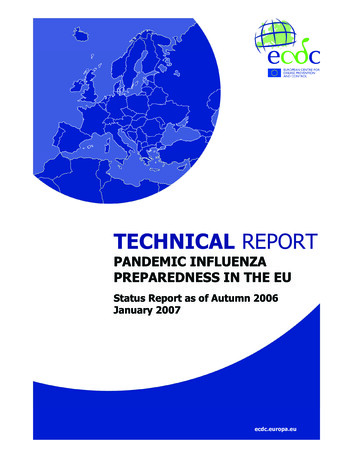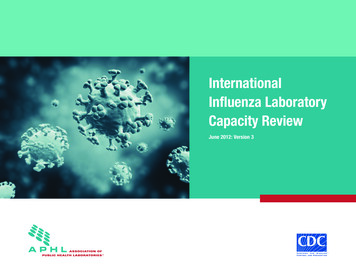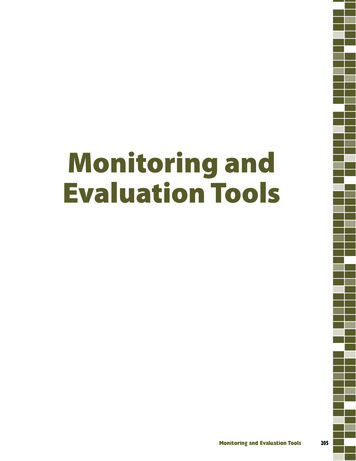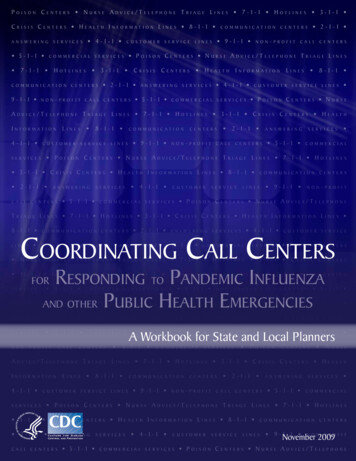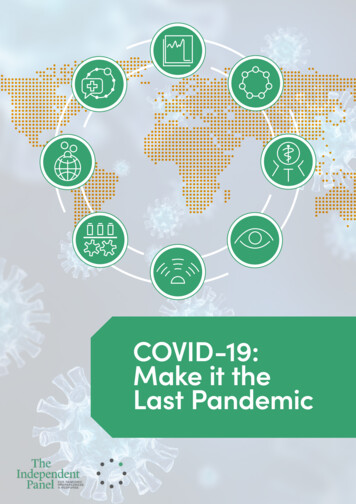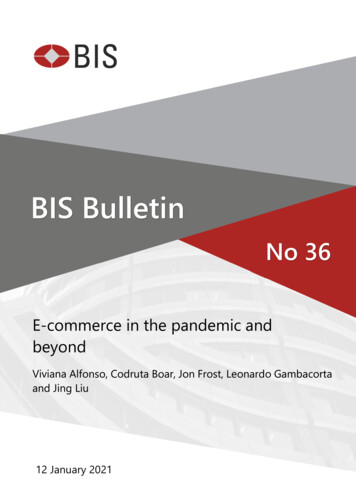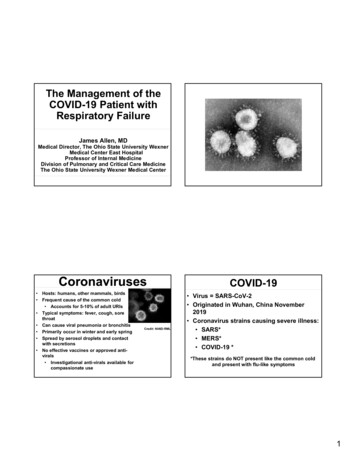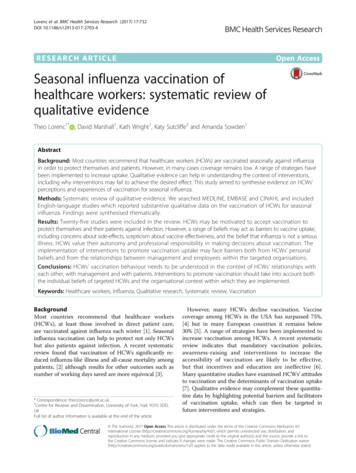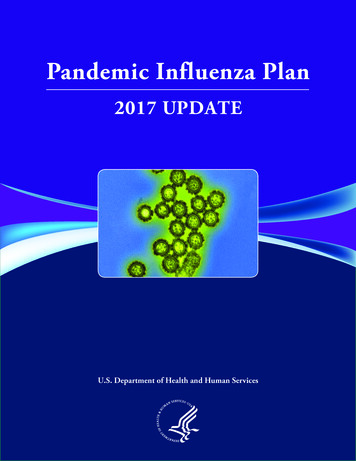
Transcription
Pandemic Influenza Plan2017 UPDATEU.S. Department of Health and Human Services
ContentsFOREWORD . 3EXECUTIVE SUMMARY . 5INTRODUCTION . 7SCOPE, AUDIENCE, AND PURPOSE . 10INFLUENZA RESPONSE ACTIVITIES . 11PLANNING TOOLS FOR PREPARATION AND RESPONSE . 12THE 2017 UPDATE TO THE HHS PANDEMIC INFLUENZA PLAN . 13Domain 1 – Surveillance, Epidemiology, and Laboratory Activities . 14Domain 2 – Community Mitigation Measures . 18Domain 3 – Medical Countermeasures: Diagnostic Devices, Vaccines,Therapeutics, and Respiratory Devices . 21Domain 4 – Health Care System Preparedness and Response Activities . 27Domain 5 – Communications and Public Outreach . 30Domain 6 – Scientific Infrastructure and Preparedness . 32Domain 7 – Domestic and International Response Policy, IncidentManagement, and Global Partnerships and Capacity Building . 35CONCLUSIONS . 40APPENDIX A . 41PLANNING SCENARIOS. 41Planning Assumptions . 42Table A.1. Estimated Illness, Types of Medical Care, and Deaths from a Moderate to VerySevere Influenza Pandemic . 44APPENDIX B . 45PLANNING TOOLS . 45Pandemic Intervals Framework . 46Figure B.1. Preparedness and response framework for novel influenza A virus pandemics:CDC intervals. 47Table B.1. Preparedness and response framework for novel influenza A virus pandemics:World Health Organization phases and CDC intervals, with federal and state/localindicators. 48Influenza Risk Assessment Tool (IRAT) . 50Pandemic Severity Assessment Framework (PSAF) . 51
FOREWORDThe last Pandemic Influenza Plan for the Department of Health and HumanServices Update was issued in 2009. Since that time, our nation has experienced, andlearned from, the 2009 Influenza A(H1N1) pandemic and the emergence of otherinfluenza viruses of concern, such as H7N9 that emerged in 2013 in China andcontinues to cause periodic outbreaks. W e have also responded to other seriousdisease outbreaks, including Ebola and Zika virus. Each instance has highlighted theneed to be as prepared as we can be—because a fast, effective public health responsedemands it.The original 2005 Plan was audacious in its goals—for domestic pandemic vaccineproduction capacity, for stockpiling of antiviral drugs and pre-pandemic vaccines, andfor using community mitigation measures to slow spread of disease. At the time of thePlan’s writing, the Nation was wholly unprepared to address the significant medical andhealth needs that a severe pandemic might present. Challenges included limiteddomestic vaccine manufacturing capacity, a very low supply of antiviral drugs, and lackof community planning for responding to an infectious disease outbreak. More than tenyears later, we have many successes to celebrate—but we must not becomecomplacent, because so many challenges remain.Today, with a domestic vaccine manufacturing capacity well-established, stockpilesmaintained, and evidence-based guidance on prevention, mitigation and treatmentavailable for state and local governments, the private sector, individuals, and families,we face different challenges—how to sustain the advances we have made, to keep upwith the changes in how people live and work, and to close in on those goals that haveproved more elusive.Pandemic influenza is different from other outbreaks we have faced because thecharacteristics of influenza viruses – their propensity to change, the ability to spreadeasily among people, and the routes of transmission – make the disease challenging tocontain. Throughout history, influenza pandemics have led to widespread illness anddeath. Pandemic influenza is not a theoretical threat; rather, it is a recurring threat.Even so, we don’t know when the next pandemic will occur, or how severe it will be.The 2005 Pandemic Influenza Plan and subsequent updates focused planning for asevere pandemic with effects that would extend beyond health consequences to includesocial and economic disruption. By preparing exclusively for a very severe pandemic,the Plan did not include specific guidance for the type of pandemic we experienced in2009, which was comparatively less severe. However, the capabilities that weredeveloped through the HHS Plan, the National Strategy for Pandemic Influenza, and itscompanion 2006 Implementation Plan, were effectively adapted and used to respond tothe pandemic that emerged. Lessons learned were captured to inform future responses.We issue this 2017 Update to the HHS Pandemic Influenza Plan with the aim ofhighlighting and building upon the successes of the last decade, and making clear the3
additional efforts that are needed to improve pandemic preparedness. These effortsare described in the seven domains that form the basis for this update.However, scientific progress in the last decade compels us not only to articulatewhat is possible, but what is needed to truly transform our pandemic preparedness—tobe more visionary. Innovation and new approaches should be considered to augmentplanning and response. With this in mind, HHS is exploring:The development of innovative diagnostic testing and disease monitoring, buildingon the emerging technologies used for personalized health, including the potential forhome diagnostic testing and on-line access to health care services.Re-conceptualizing respiratory protection to limit transmission of disease from thosewho are infected to those who are well and protect caregivers and other responders byredesigning respiratory protective devices so they provide better protection and areeasy and practical to use.Accelerating vaccine and antiviral development, with a goal of having vaccine readyfor administration within 3 months of the emergence of a pandemic strain, and approvedbroad spectrum antiviral therapies suitable for a range of influenza and other viralpathogens.Modernizing medical countermeasure distribution and administration by linkinginformation technology and modern supply chain science to patterns of human behaviorand care seeking.Ensuring people get the right care at the right place and at the right time, beginningwith tools to aid individuals in their care seeking and decision making, andimplementing surge strategies so that people receive care that is safe and appropriateto their level of need, thereby conserving higher levels of care for those who need it.These goals are attainable, but achieving them will require dedication in terms ofresources, innovation, education and outreach, and commitment. Although pandemicinfluenza threats are one of the greatest public health challenges of our time, otheremerging infectious diseases can also have a devastating impact on human health.Balancing the need to respond to threats as they emerge with the long-termpreparedness activities needed to mitigate them represents a significant challenge.However, the capacity and capabilities developed for pandemic influenzapreparedness will enable HHS to respond more effectively to other emerginginfectious diseases.4
EXECUTIVE SUMMARYIn 2005, the U.S. Department of Health and Human Services (HHS) developed theHHS Pandemic Influenza Plan to prevent, control, and mitigate the effects of influenzaviruses that pose high risk to humans. Influenza viruses, of which there are many types,can cause rapid, widespread disease and death. Pandemic influenza outbreaks in the20th Century alone left tens of millions of people dead in their wake and cost hundredsof billions of dollars in lost lives, wages, productivity and economic devastation.Influenza viruses with pandemic potential require the rapid development, productionand availability of medical countermeasures (MCMs) such as vaccines, diagnostics andantiviral drugs to mitigate the impact of the pandemic, as well as additionalpreparedness and response efforts beyond medical countermeasures.HHS has made substantial progress in pandemic influenza preparedness since the2005 Plan was released. In the current document, HHS reviews that progress,highlighting both the successes and remaining gaps in our preparedness and responseactivities for pandemic influenza. Most significantly, HHS efforts in pandemic influenzapreparedness now are closely aligned with seasonal influenza activities, harnessingexpanded surveillance, laboratory, vaccine, and antiviral drug resistance monitoringcapacity. These activities are linked to efforts to communicate protective measures tothe public and to help the health care system manage the demands of seasonal andpotential pandemic influenza. Research across all these areas, and increased globalcapacity to diagnose and type the influenza viruses encountered outside the UnitedStates, contribute to domestic preparedness against pandemic influenza.The original 2005 Plan consisted of four key pandemic response elements. This2017 Update builds upon goals elaborated in the 2005 Plan and, using evolving scienceand budget priorities, identifies domains, goals, objectives, and key actions to serve asplanning guides for the next decade. The seven domains for 2017-2027 are:1. Surveillance, Epidemiology, and Laboratory Activities - Better detection andmonitoring of seasonal and emerging novel influenza viruses are critical to assuring arapid recognition and response to a pandemic. Over the next decade, HHS willincrease use of new gene sequencing technologies for detecting and characterizinginfluenza viruses in the U.S. and globally. Candidate vaccine viruses will be morerapidly developed and synthesized when needed, to speed manufacturing of vaccines.Greater use of ‘big data’, analytics, and forecasting will enhance surveillance andplanning.2. Community Mitigation Measures - Incorporating actions and response measurespeople and communities can take to help slow the spread of novel influenza virus.Community mitigation measures may be used from the earliest stages of an influenzapandemic, including the initial months when the most effective countermeasure—avaccine against the new pandemic virus—might not yet be broadly available.3. Medical Countermeasures: Diagnostic Devices, Vaccines, Therapeutics, and5
Respiratory Devices - Aggressive translation of applied research in diagnostics,therapeutics, and vaccines may yield breakthrough MCMs to mitigate the nextinfluenza pandemic. Building on existing systems for product logistics, as well asadvances in technology and regulatory science, can increase access to and use ofcritical countermeasures to inform response activities.4. Health Care System Preparedness and Response Activities - Delivery systemreform efforts of the past decade have made today’s health care system dramaticallydifferent from 2005. The next 10 years will bring even more changes to deliverysettings, provider types, reimbursement models, the sharing of electronic healthinformation, referral patterns, business relationships, and expanded individual choice.Despite these changes, health care systems must be prepared to respond to apandemic, recognizing that potentially large numbers of people with symptoms ofinfluenza, as well as those concerned about the pandemic will present for care.Systems must implement surge strategies so people receive care that is appropriate totheir level of need, thereby conserving higher levels of care for those who need them.HHS must keep abreast of these changes and adapt tools and strategies accordingly.5. Communications and Public Outreach - Communications planning is integral toearly and effective messaging when a pandemic threatens, establishes itself, andexpands. Accurate, consistent, timely, and actionable communication is enhanced bythe use of plain language and accessible formats. Testing messages and usingappropriate channels and spokespeople will enhance our ability to deliver consistentand accurate information to multiple audiences.6. Scientific Infrastructure and Preparedness - A strong scientific infrastructureunderpins everything HHS does to prepare for, and respond to, pandemic influenza andother emerging infectious diseases. Strong scientific foundations are needed to developnew vaccines and therapeutics, and to determine how well other control efforts areworking. Rigorous scientific methods applied during a pandemic response yieldinformation to improve both ongoing and future responses.7. Domestic and International Response Policy, Incident Management, andGlobal Partnerships and Capacity Building - HHS will continue to coordinate bothdomestic and international pandemic preparedness and response activities. This willinclude having clearly defined mechanisms for rapid exchange of information, data,reagents and other resources needed domestically and globally, to prepare for andrespond to an influenza pandemic outbreak.These domains reflect an end-to-end systems approach to improving the waypreparedness and response are integrated across sectors and disciplines, whileremaining flexible for the conditions surrounding a specific pandemic. This will allow HHSto respond more quickly to a future influenza pandemic and, at the same time, strengthenour response to seasonal influenza to mitigate the next influenza pandemic.6
INTRODUCTIONInfluenza viruses have been shown to be capable of causing rapid, widespreadmorbidity and mortality among infected humans. Pandemics happen when new (novel)influenza A viruses emerge which are able to infect people easily and spread fromperson to person in an efficient and sustained way. Historically, pandemic outbreaks ofinfluenza viruses have left tens of millions of people dead in their wake and have costhundreds of billions of dollars in lost lives, wages, productivity and economicdevastation. In 1997, highly pathogenic avian influenza (HPAI) A(H5N1) viruses jumpedfrom birds to humans in Hong Kong; six of 18 people with confirmed infections fromH5N1 influenza virus died. In 2003, avian influenza A(H5N1) viruses emerged inhumans again, this time in Southeast Asia, leading to severe illness and further deathscaused by this virus. Since 1997, over 1826 confirmed human infections and 784deaths have been caused by avian influenza A(H5N1) around the world. The continualevolution and spillover of avian influenza viruses from birds into humans, coupled withtheir potential to rapidly spread and cause severe illness and death in people who areimmunologically naïve triggered a global assessment of preparedness and responsecapabilities for a pandemic outbreak caused by influenza.In 2005, the U.S. Department of Health and Human Services (HHS) developed theHHS Pandemic Influenza Plan to prevent, control, and mitigate the effects of influenzaA(H5N1) and other influenza viruses assessed to pose high risk to humans. Since theiremergence in 1997, A(H5N1) viruses have become enzootic among poultry in manyparts of the world, causing sporadic human infections and deaths. Influenza A(H5N1) isnot the only animal influenza virus to infect humans. Mammalian influenza viruses (e.g.,swine variant viruses H1N1v, H1N2v, H3N2v) and other avian influenza viruses (H5N2,H5N6, H5N8, H7N9) pose threats to humans. For example, since 2013 over onethousand human infections caused by avian influenza A(H7N9) virus have beenreported, predominantly in China. In late 2014 and 2015, highly pathogenic avianinfluenza (HPAI) A(H5N8) viruses spread to birds in the United States from Asia andmixed with North American viruses. The resulting A(H5Nx) virus caused outbreaks inpoultry in 15 states (predominantly A/H5N2), affecting 50.4 million birds. An aggressiveanimal response plan curtailed the outbreak but resulted in the slaughter of 7.5 millionturkeys and 42.1 million egg-layer and pullet chickens, costing federal taxpayers morethan 950 million. 1 An aggressive public health response that emphasized monitoring ofexposed responders and the general public found no human infections with these avianviruses.Over the past decade, the global public health community ramped up pandemicinfluenza preparedness efforts with an eye toward the emergence of HPAI influenzaA(H5N1) viruses in Asia; however the real-life test of pandemic planning came in 2009following the emergence of a novel H1N1 virus in North America. The 2009 pandemicwas caused by a novel reassortant virus designated A(H1N1)pdm09. This pandemicillustrated that pandemic influenza viruses can originate anywhere, vary in severity and1Animal and Plant Health Inspection Service. “2016 HPAI Preparedness and Response Plan.” Washington, DC: USDepartment of Agriculture, 2016. Accessed 7/31/2016.7
population penetration, and each pandemic will differ in its range and impact. It alsohighlighted the speed with which a novel influenza A virus can be transmitted amongpeople, respecting no geographic or jurisdictional boundaries, and the need for rapiddevelopment, production and availability of MCMs such as vaccines, diagnostics andantiviral drugs to mitigate the impact of the pandemic. Lessons learned from the 2009H1N1 influenza pandemic were published in 2012 as the 2009 H1N1 InfluenzaImprovement Plan, and the W orld Health Organization (WHO) released its PandemicInfluenza Risk Management Interim Guidance in 2013. In 2016-2017, HHS reviewed theprogress made since the 2009 H1N1 Influenza Improvement Plan.This document highlights both the progress and remaining gaps in ourpreparedness and response capabilities for pandemic influenza. It serves as an Updateof the 2005 HHS Pandemic Influenza Plan and its interim updates issued in June 2006,November 2006, and January 2009, and sets the course for the next decade.Accomplishments over the past decade reflect significant HHS effort andinvestments in pandemic preparedness and are described in the following sections.Expanded global influenza surveillance and laboratory capacity provide a clearer pictureof evolving influenza A viruses and the occurrence of novel viruses with pandemicpotential. Forecasting, modeling and planning tools now facilitate dynamic estimates ofpandemic virus spread, burden and impact. The National Pre-Pandemic InfluenzaVaccine Stockpile (NPIVS) has been established and satisfies requirements for vaccineand adjuvants to address influenza viruses that are assessed to be the highest risk forhuman infection. Modifications made to respiratory devices—both respirators andventilators—should ensure better availability and improved technology in a futurepandemic. Influenza vaccines can be produced more rapidly, and there is now sufficientdomestic manufacturing capacity to make influenza vaccine for every person in theUnited States. The goal of a 12-week time frame for first doses of vaccine is now withinreach, compared with the typical six to nine month time for seasonal vaccine production,though challenges may still persist in ensuring enough supply of pandemic vaccine isimmediately available for the entire population. Influenza antiviral drugs are available inmany formulations, including some specifically for children. Federal stockpiles of antiviraldrugs have increased to levels projected to meet treatment needs across multiplepandemic scenarios. Vaccines are now more broadly available in many settings,including pharmacies and retail clinics, to improve access to these countermeasures andreduce the surge on hospital and emergency care centers during a pandemic. Socialmedia messaging channels now reach millions of Americans directly, and expandedpartnerships with an array of nongovernmental organizations can deliver influenzapandemic-related messages through those channels. The health care and public healthsystems have begun to plan for implementation of principles articulated in CrisisStandards of Care: Systems Framework for Catastrophic Disaster Response, if neededduring a severe pandemic. Robust population-based surveillance and evaluationnetworks capture influenza-associated hospitalizations and monitor the effectiveness ofinfluenza antivirals and vaccines. Finally, State, Local, Tribal, and Territorialgovernments (SLTT) have developed, and many have exercised, pandemic influenzapreparedness plans, supporting global commitments made by the United States topandemic preparedness planning.8
Complementing progress on the domestic front, HHS has made significantimprovements in strengthening global capacities to prevent, detect, and respond to aninfluenza pandemic. A robust international surveillance network has been establishedby partnering with more than fifty countries to build capacity to detect novel influenzaviruses wherever they emerge. HHS participated in the development and adoption in2011 of the WHO Pandemic Influenza Preparedness (PIP) Framework for the Sharingof Influenza Viruses and Access to Vaccines and Other Benefits. In addition, expandedinternational coordination on pandemic preparedness and response has been facilitatedby HHS’s continued support to the WHO Global Influenza Surveillance and ResponseSystem (GISRS). This system not only allows for the capture of more viruses frommore places for greater ability to detect an emerging pandemic threat, but also toproduce timely seasonal and pandemic vaccine candidates. HHS also supported thedevelopment of influenza vaccine manufacturing capacity in developing countries,creating a rapid response capability of over 500 million doses of pandemic influenzavaccine in remote regions where previously there was none. Finally, HHS hasintegrated its domestic and international pandemic response policies and operations tominimize duplication of effort. HHS led the development of the North American Plan forAnimal and Pandemic Influenza (NAPAPI), which launched in 2012 as the primaryframework for pandemic influenza preparedness and response through collaborationamong the United States, Canada, and Mexico. The Global Health Security Agenda,which officially launched in 2014, and the continued efforts to implement theInternational Health Regulations (IHR), published in 2005 by the W HO, both highlightthe ongoing need to establish or improve the global capacity to prevent, detect, andrespond to biological threats such as pandemic influenza.All of these international activities serve to directly improve national security asthey enable rapid communications, surveillance, and mitigation of emerging novelinfluenza viruses with other countries to ensure a better national response.Today, domestic and global public health preparedness and response benefit fromimproved products, responsive manufacturing, and broader disease surveillance.However, much remains to be done even as these critical efforts must be sustained.This 2017 Update describes HHS’s progress over the past decade of influenzaresponse activities and the critical objectives for the decade ahead.9
SCOPE, AUDIENCE, AND PURPOSEPandemic preparedness planning has become more sophisticated and has grownin breadth and depth across all levels of government, stakeholders, private entities, andsectors over the past ten years. Today, every state, four major metropolitan areas, andeight U.S. territories and freely associated states have their own pandemic influenzaplan. HHS support has expanded public health and health care preparednesscapabilities domestically and abroad, improved laboratory diagnostics, and enhanceddevelopment and manufacturing of MCMs.This 2016 Update describes the HHS approach to protecting human health before,during, and after an influenza pandemic. To sustain the momentum of the past decade,the pandemic preparedness work that lies ahead must take advantage of new oremerging opportunities posed by improvements in technology, detection andassessment of viruses, and enhanced response capacities both domestically andinternationally.Stakeholders in this effort comprise an array of public and private entities: SLTTpolicymakers; critical infrastructure sectors such as public health, health care, socialservices, research, manufacturing, and education and child care; employers;international and multilateral partners in these areas; and the general public, who needto know not only how HHS fulfills its mission, but also how they can take actions to helpreduce the spread of influenza, whether in a pandemic or every year during theinfluenza season.Finally, whereas this 2017 Update primarily addresses pandemic influenza, thecontinually changing nature of influenza viruses that can lead to mismatches betweenvaccine strains and circulating viruses, as seen during the 2014–2015 influenzaseason, remind us that pandemic and seasonal influenza planning and improvementefforts are interdependent. Both rely on a strong and sustainable public health systeminfrastructure that can rapidly detect, and respond to, changes in circulating influenzaviruses. Many of the activities that HHS and its partners undertake each year tounderstand and mitigate the impact of seasonal influenza are critical to a pandemicresponse both domestically and globally, so this 2016 Update reinforces criticalconnections between seasonal and pandemic influenza preparedness and response.10
INFLUENZA RESPONSE ACTIVITIESYear-round seasonal influenza activities provide the foundation for any influenzapandemic response. Surveillance and monitoring, research and development, delivery ofMCMs (for example, vaccines and therapeutics, diagnostics, and respiratory protectivedevices) and non-pharmaceutical interventions (NPIs), health care system response,and communications are integral to the domains and objectives described in detail laterin this Update. Public health preparedness work on seasonal influenza continuesthroughout the year because influenza viruses circle the globe in a constant state ofevolution and emergence that necessitates annual updates to the vaccine formulationfor both the Northern and Southern Hemispheres. Detecting unpredictable outbreaks ofnovel influenza viruses with human pandemic potential might prompt a sudden changein this mode of operation, which must be addressed by accelerating and amplifying thiswork specifically with the new virus. It also affects incident response activities, whichprioritize and coordinate public health efforts to address a potential pandemic,sometimes even as the seasonal influenza efforts must continue. Shortly after a novelinfluenza virus has been detected and transmitted among humans, HHS will havedetermined if vaccines in the NPIVS are likely to offer protection, begun to develop asafe and effective vaccine against the novel influenza virus, determined its susceptibilityto antiviral drugs, and triggered a series of domestic and international response activitiesto mitigate the potential risk of further spread of the virus. A comprehensive U.S.government (USG)-coordinated pandemic response will consider an array of nonpharmaceutical and pharmaceutical intervention options to mitigate pandemic impact onpublic health.Despite uncertainty in future pandemic influenza scenarios, developing andimplementing a set of planning principles and parameters encompassing a range ofpotential pandemic impacts will be critical to ensure a prompt and flexible response.Therefore, HHS has developed a process to assess various risk scenarios that estimateillness, outpatient medical care, hospitalizations, intensive care unit care, and deaths forlow, moderate, high, and very high severity pandemics. Appendix A contains moreinformation about pandemic influenza scenarios and planning assumptions.11
PLANNING TOOLS FOR PREPARATION AND RESPONSEAt the onset of an outbreak with pandemic potential, the uncertainty and complexityof the situation demand ways to assess the risk and potential public health impactposed by the emerging virus, understand the possible progression of the event, andevaluate its severity and transmissibility to enable informed public health interventions.HHS has developed and refined three tools over the past decade to help guide differentaspects of planning and response: the Pandemic Intervals Framework (PIF), theInfluenza Risk Assessment Tool (IRAT), and the Pandemic Severity AssessmentFramework (PSAF). Details about these tools are included in Appendix B. These toolsalign with the W HO initiative for all nations to develop response plans within the W HO’sglobal framework of pandemic phases and risk-assessment activities for preparedness,response, and
2005 Plan was released. In the current document, HHS reviews that progress, highlighting both the successes and remaining gaps in our preparedness and response activities for pandemic influenza. Most significantly, HHS efforts in pandemic influenza preparedness now are closely aligned with
